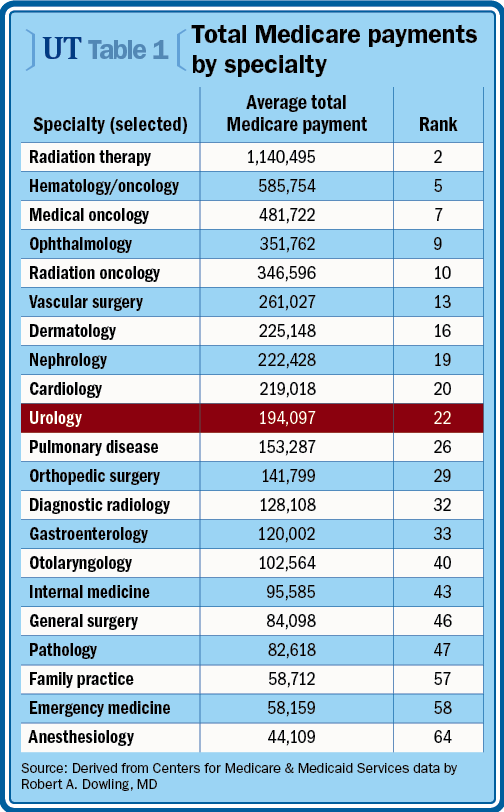Article
CMS data offer insights into urologists’ pay
This article focuses on the the Centers for Medicare & Medicaid Services' recently released 2013 utilization and payment data and what they tell us about the business of urology.

Robert A. Dowling, MDThe Centers for Medicare & Medicaid Services recently released 2013 utilization and payment data with information on services and procedures provided to Medicare beneficiaries under the fee-for-service program (http://ow.ly/PUu6L). Part of a larger effort to make the health care system transparent, this and other “public use files” released by CMS provide some insight into the utilization patterns of providers, as well as other statistics, trends, and reports that can be used by researchers and other health care stakeholders. CMS provides detailed de-identified information at the provider and procedure level based on its national claims history files.
More from Dr. Dowling - Social media: Why you need to be involved
This article will focus on the aggregated 2013 data files and what they tell us about the business of urology.

The 2013 public use file is based on 100% of the fee-for-service claims paid to non-institutional providers (durable medical equipment, prosthetic, and orthotics contractors are excluded). According to the data, 8,980 unique urology providers were paid a total of $1.743 billion in 2013 claims. This represents 0.93% of unique total providers paid (956,293), and 1.95% of the total Medicare payments to providers in that year ($89.235 billion). For context, urology ranks 22nd out of 91 specialties in average total Medicare payment (table 1). The pertinent statistics per urology provider are shown in table 2.
Data on average total payment revealed
Medicare Part B fee-for-service payments to providers have been categorized in the data file as drug services and medical services. Drug services are defined as those listed in the Medicare Part B Drug Average Sales Price (ASP) file (http://ow.ly/PUuf0); medical services are all those not listed in the same file. In 2013, the average total Medicare payment to a urology provider was $194,097 within a very large range ($81-$2,089,037); 80% of providers received less than $292,000, only 383 providers (4.3%) received more than $500,000, and 37 providers (0.4%) received more than $1,000,000 in 2013. Further analysis of the data reveals that the average Medicare total payment per beneficiary to urology providers was $333, and the average total payment per service was $62.
NEXT: CMS urology provider data
Have you read:
mCRPC advances come with choices, challenges
How to prevent medication errors in your practice
True informed consent bolsters patient safety
Drug services are typically reimbursed at 106% of the amount listed in ASP files updated quarterly, so urology providers are theoretically spending all but 6% of their Medicare drug revenue on drug acquisition costs. This is also known as “buy and bill.” CMS suppresses the breakdown of drug and medical claims for providers with fewer than 11 beneficiaries in order to prevent possible identification of patients from the data; the aggregate statistics are not significantly affected by this exclusion. The average drug payment to urology providers in 2013 was $35,583 within a very large range ($0-$1,244,868). Eighty percent of providers received less than $125,000, 0.18% (16) providers more than $500,000, and 0.03% (three) providers more than $1,000,000.

Bottom line: Data on payments from government programs to physicians-including urologists-are available to the public for research and analysis. The 2013 public use files demonstrate that urology providers rank in the top quartile among Medicare specialties in average total payments from Medicare, and that the vast majority of providers in our specialty are clustered around the mean. Drug payments to urology providers account for less than 20%, on average, of total payments and the profit margin on that revenue is expected to be 6% or less. While it is impossible to use this data to analyze the appropriateness or quality of care, the aggregate information should be of interest to urologists as we enter an age of transparency and data availability. Others have this information, and so should you.
More from Urology Times:
Why organized medicine needs to operate more like Google
Hypospadias repair: AUA creates new consensus document on coding
Retirement age key to Social Security timing
Subscribe to Urology Times to get monthly news from the leading news source for urologists.

















